Wonhyuk Ahn
Nearly Zero-Cost Protection Against Mimicry by Personalized Diffusion Models
Dec 16, 2024Abstract:Recent advancements in diffusion models revolutionize image generation but pose risks of misuse, such as replicating artworks or generating deepfakes. Existing image protection methods, though effective, struggle to balance protection efficacy, invisibility, and latency, thus limiting practical use. We introduce perturbation pre-training to reduce latency and propose a mixture-of-perturbations approach that dynamically adapts to input images to minimize performance degradation. Our novel training strategy computes protection loss across multiple VAE feature spaces, while adaptive targeted protection at inference enhances robustness and invisibility. Experiments show comparable protection performance with improved invisibility and drastically reduced inference time. The code and demo are available at \url{https://webtoon.github.io/impasto}
Imperceptible Protection against Style Imitation from Diffusion Models
Mar 28, 2024Abstract:Recent progress in diffusion models has profoundly enhanced the fidelity of image generation. However, this has raised concerns about copyright infringements. While prior methods have introduced adversarial perturbations to prevent style imitation, most are accompanied by the degradation of artworks' visual quality. Recognizing the importance of maintaining this, we develop a visually improved protection method that preserves its protection capability. To this end, we create a perceptual map to identify areas most sensitive to human eyes. We then adjust the protection intensity guided by an instance-aware refinement. We also integrate a perceptual constraints bank to further improve the imperceptibility. Results show that our method substantially elevates the quality of the protected image without compromising on protection efficacy.
Advancing Beyond Identification: Multi-bit Watermark for Language Models
Aug 01, 2023


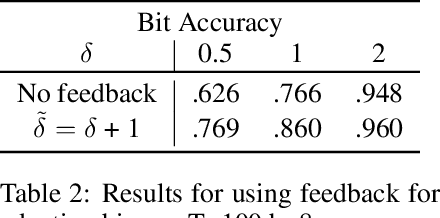
Abstract:This study aims to proactively tackle misuse of large language models beyond identification of machine-generated text. While existing methods focus on detection, some malicious misuses demand tracing the adversary user for counteracting them. To address this, we propose "Multi-bit Watermark through Color-listing" (COLOR), embedding traceable multi-bit information during language model generation. Leveraging the benefits of zero-bit watermarking (Kirchenbauer et al., 2023a), COLOR enables extraction without model access, on-the-fly embedding, and maintains text quality, while allowing zero-bit detection all at the same time. Preliminary experiments demonstrates successful embedding of 32-bit messages with 91.9% accuracy in moderate-length texts ($\sim$500 tokens). This work advances strategies to counter language model misuse effectively.
Robust Natural Language Watermarking through Invariant Features
May 03, 2023Abstract:Recent years have witnessed a proliferation of valuable original natural language contents found in subscription-based media outlets, web novel platforms, and outputs of large language models. Without proper security measures, however, these contents are susceptible to illegal piracy and potential misuse. This calls for a secure watermarking system to guarantee copyright protection through leakage tracing or ownership identification. To effectively combat piracy and protect copyrights, a watermarking framework should be able not only to embed adequate bits of information but also extract the watermarks in a robust manner despite possible corruption. In this work, we explore ways to advance both payload and robustness by following a well-known proposition from image watermarking and identify features in natural language that are invariant to minor corruption. Through a systematic analysis of the possible sources of errors, we further propose a corruption-resistant infill model. Our full method improves upon the previous work on robustness by +16.8% point on average on four datasets, three corruption types, and two corruption ratios. Code available at https://github.com/bangawayoo/nlp-watermarking.
Detection of Double Compression in MPEG-4 Videos Using Refined Features-based CNN
Jul 19, 2021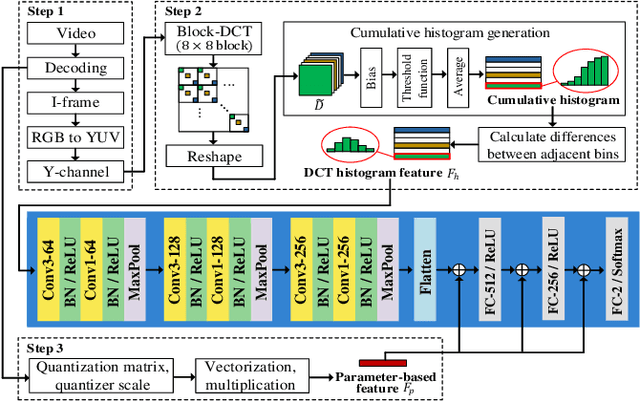


Abstract:Double compression is accompanied by various types of video manipulation and its traces can be exploited to determine whether a video is a forgery. This Letter presents a convolutional neural network for detecting double compression in MPEG-4 videos. Through analysis of the intra-coding process, we utilize two refined features for capturing the subtle artifacts caused by double compression. The discrete cosine transform (DCT) histogram feature effectively detects the change of statistical characteristics in DCT coefficients and the parameter-based feature is utilized as auxiliary information to help the network learn double compression artifacts. When compared with state-of-the-art networks and forensic method, the results show that the proposed approach achieves a higher performance.
Frame-rate Up-conversion Detection Based on Convolutional Neural Network for Learning Spatiotemporal Features
Mar 25, 2021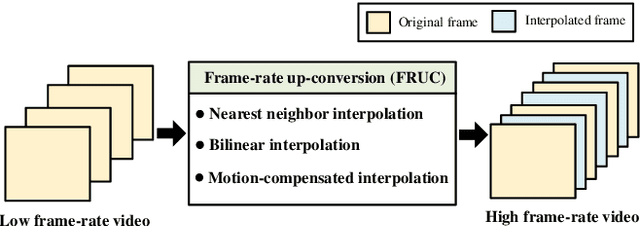
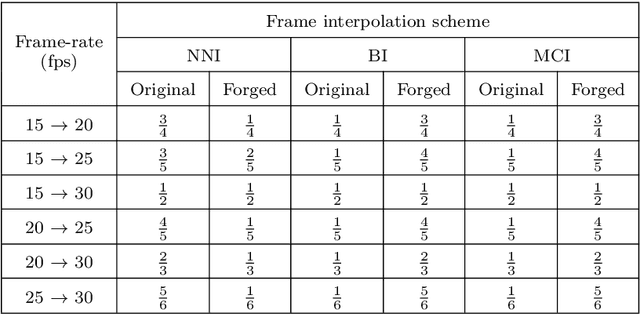


Abstract:With the advance in user-friendly and powerful video editing tools, anyone can easily manipulate videos without leaving prominent visual traces. Frame-rate up-conversion (FRUC), a representative temporal-domain operation, increases the motion continuity of videos with a lower frame-rate and is used by malicious counterfeiters in video tampering such as generating fake frame-rate video without improving the quality or mixing temporally spliced videos. FRUC is based on frame interpolation schemes and subtle artifacts that remain in interpolated frames are often difficult to distinguish. Hence, detecting such forgery traces is a critical issue in video forensics. This paper proposes a frame-rate conversion detection network (FCDNet) that learns forensic features caused by FRUC in an end-to-end fashion. The proposed network uses a stack of consecutive frames as the input and effectively learns interpolation artifacts using network blocks to learn spatiotemporal features. This study is the first attempt to apply a neural network to the detection of FRUC. Moreover, it can cover the following three types of frame interpolation schemes: nearest neighbor interpolation, bilinear interpolation, and motion-compensated interpolation. In contrast to existing methods that exploit all frames to verify integrity, the proposed approach achieves a high detection speed because it observes only six frames to test its authenticity. Extensive experiments were conducted with conventional forensic methods and neural networks for video forensic tasks to validate our research. The proposed network achieved state-of-the-art performance in terms of detecting the interpolated artifacts of FRUC. The experimental results also demonstrate that our trained model is robust for an unseen dataset, unlearned frame-rate, and unlearned quality factor.
WAN: Watermarking Attack Network
Aug 14, 2020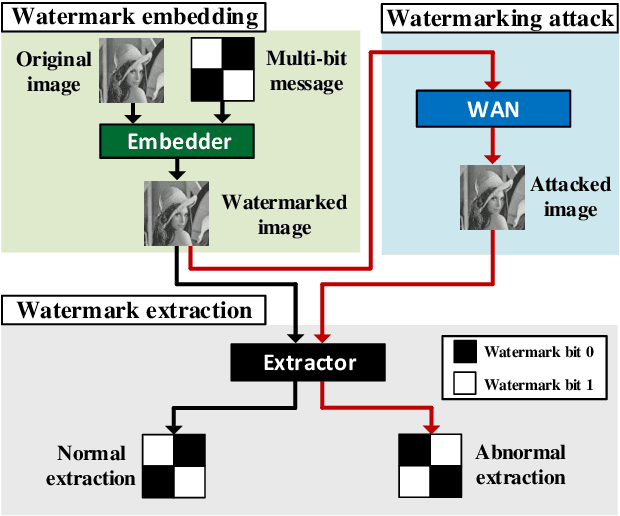

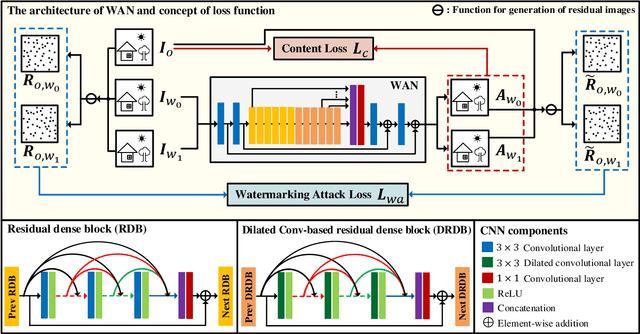

Abstract:Multi-bit watermarking (MW) has been developed to improve robustness against signal processing operations and geometric distortions. To this end, several benchmark tools that simulate possible attacks on images to test robustness are available. However, limitations in these general attacks exist since they cannot exploit specific characteristics of the targeted MW. In addition, these attacks are usually devised without consideration for visual quality, which rarely occurs in the real world. To address these limitations, we propose a watermarking attack network (WAN), a fully trainable watermarking benchmark tool, that utilizes the weak points of the target MW and removes inserted watermark and inserts inverted bit information, thereby considerably reducing watermark extractability. To hinder the extraction of hidden information while ensuring high visual quality, we utilize a residual dense blocks-based architecture specialized in local and global feature learning. A novel watermarking attack loss is introduced to break the MW systems. We empirically demonstrate that the WAN can successfully fool a variety of MW systems.
Deep Convolutional Neural Network for Identifying Seam-Carving Forgery
Jul 07, 2020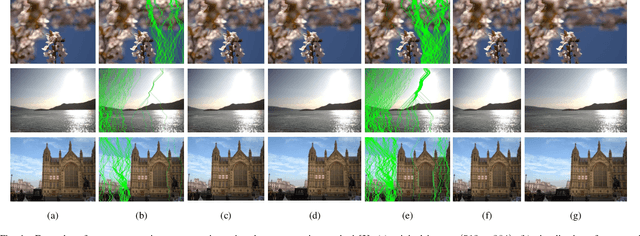

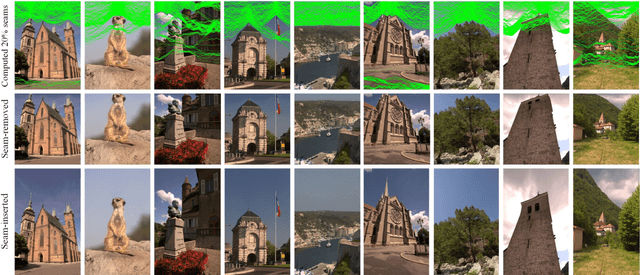

Abstract:Seam carving is a representative content-aware image retargeting approach to adjust the size of an image while preserving its visually prominent content. To maintain visually important content, seam-carving algorithms first calculate the connected path of pixels, referred to as the seam, according to a defined cost function and then adjust the size of an image by removing and duplicating repeatedly calculated seams. Seam carving is actively exploited to overcome diversity in the resolution of images between applications and devices; hence, detecting the distortion caused by seam carving has become important in image forensics. In this paper, we propose a convolutional neural network (CNN)-based approach to classifying seam-carving-based image retargeting for reduction and expansion. To attain the ability to learn low-level features, we designed a CNN architecture comprising five types of network blocks specialized for capturing subtle signals. An ensemble module is further adopted to both enhance performance and comprehensively analyze the features in the local areas of the given image. To validate the effectiveness of our work, extensive experiments based on various CNN-based baselines were conducted. Compared to the baselines, our work exhibits state-of-the-art performance in terms of three-class classification (original, seam inserted, and seam removed). In addition, our model with the ensemble module is robust for various unseen cases. The experimental results also demonstrate that our method can be applied to localize both seam-removed and seam-inserted areas.
BitMix: Data Augmentation for Image Steganalysis
Jun 30, 2020



Abstract:Convolutional neural networks (CNN) for image steganalysis demonstrate better performances with employing concepts from high-level vision tasks. The major employed concept is to use data augmentation to avoid overfitting due to limited data. To augment data without damaging the message embedding, only rotating multiples of 90 degrees or horizontally flipping are used in steganalysis, which generates eight fixed results from one sample. To overcome this limitation, we propose BitMix, a data augmentation method for spatial image steganalysis. BitMix mixes a cover and stego image pair by swapping the random patch and generates an embedding adaptive label with the ratio of the number of pixels modified in the swapped patch to those in the cover-stego pair. We explore optimal hyperparameters, the ratio of applying BitMix in the mini-batch, and the size of the bounding box for swapping patch. The results reveal that using BitMix improves the performance of spatial image steganalysis and better than other data augmentation methods.
 Add to Chrome
Add to Chrome Add to Firefox
Add to Firefox Add to Edge
Add to Edge